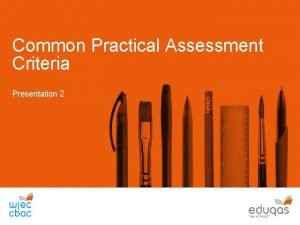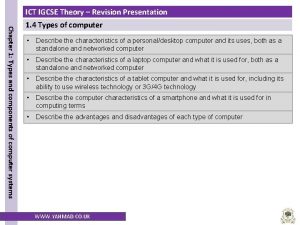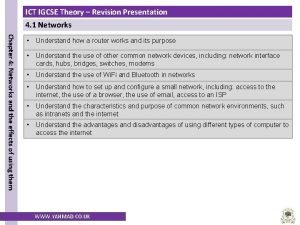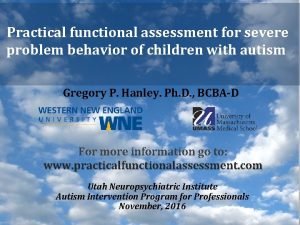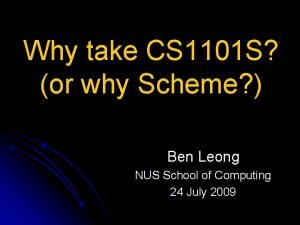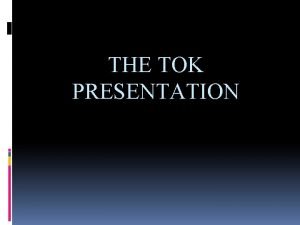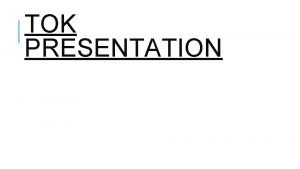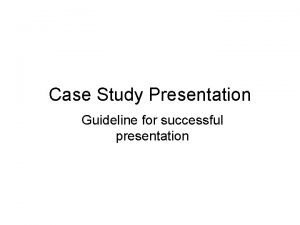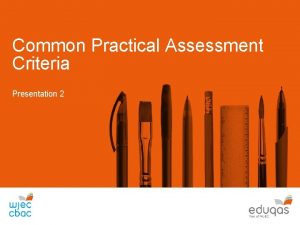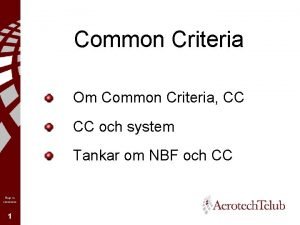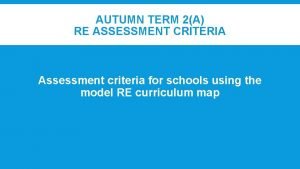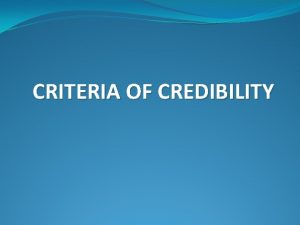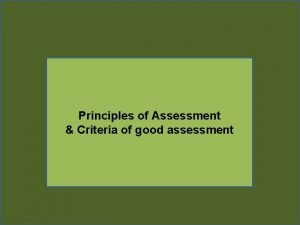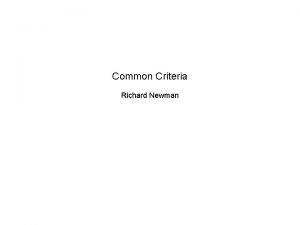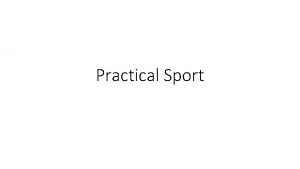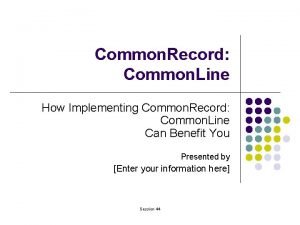Common Practical Assessment Criteria Presentation 2 The criteria


















- Slides: 18

Common Practical Assessment Criteria Presentation 2

The criteria CPAC 1 Follows written procedures CPAC 2 Applies investigative approaches and methods when using instruments and equipment CPAC 3 Safely uses a range of practical equipment and materials CPAC 4 Makes and records observations CPAC 5 Researches, references and reports

The criteria for a pass In order to be awarded a Pass a Learner must, by the end of the practical science assessment, consistently and routinely meet the criteria in respect of each competency. A Learner may demonstrate the competencies in any practical activity undertaken as part of that assessment throughout the course of study.

General key points about the competencies • Need to plan for a suitable balance on the competencies over the 2 years • No need to sub-divide the competencies up • Don’t try and assess all the CPAC standards in one practical

CPAC 1: Follows written procedures (a) Correctly follows instructions to carry out the experimental techniques or procedures.

CPAC 1 Key points to note: • This is generally being done well

CPAC 2: Applies investigative approaches and methods when using instruments and equipment a) Correctly uses appropriate instrumentation, apparatus and materials (including ICT) to carry out investigative activities, experimental techniques and procedures with minimal assistance or prompting. b) Carries out techniques or procedures methodically, in sequence and in combination, identifying practical issues and making adjustments when necessary. c) Identifies and controls significant quantitative variables where applicable, and plans approaches to take account of variables that cannot readily be controlled. d) Selects appropriate equipment and measurement strategies in order to ensure suitably accurate results.

CPAC 2 Key points to note: • Most difficult CPAC for learners to evidence • This CPAC should focus on the choice of equipment • This will be covered more in Year 13 than Year 12 • It needs to be clear that there are planned opportunities for it to take place in Year 13 • Sometimes being awarded in Year 12 where the learners don’t really have the opportunity to design the experiment • Make use of the period at the end of Year 12 to introduce the assessment of this CPAC

CPAC 3: a) Identifies hazards and assesses risks associated with these Safely uses a range of hazards, making safety adjustments as necessary, when practical equipment and carrying out experimental techniques and procedures in the lab materials or field. b) Uses appropriate safety equipment and approaches to minimise risks with minimal prompting.

CPAC 3 Key points to note: • This is generally being done well • Don’t assess it every time • Plenty of opportunity just carefully choose the occasion • Full risk assessment not needed but candidates must be able to identify risks and hazards and work safely.

CPAC 4: Makes and records observations (a) Makes accurate observations relevant to the experimental or investigative procedure. (b) Obtains accurate, precise and sufficient data for experimental and investigative procedures and records this methodically using appropriate units and conventions.

CPAC 4 Key points to note: • Being used incorrectly to assess the graph it mainly involves the table of raw data • Tables and graphs not always presented well • Quality of raw data recording was quite variable • Level of precision was inconsistent • Results should not be copied up later • Should come from the setting up of their own equipment and not the choice

CPAC 5: Researches, references and reports (a) Uses appropriate software and/or tools to process data, carry out research and report findings. (b) Sources of information are cited demonstrating that research has taken place, supporting planning and conclusions.

CPAC 5 – this is occasionally confused with CPAC 4 Key points to note: • There are two parts: processing data and carrying out research and reporting findings AND referencing • Data may be processed using mathematical relationships or using graphs. Spreadsheets can be used but tools could also include more traditional methods. • Candidates should reference sources of information whether a data value or statement from a website by stating the URL and the data accessed – the Harvard system is not necessary

The standard See word documents 2. 3 The Standard 2. 4 Pen portraits

Entries for the practical endorsement (summer 2019)

• Annual head of centre declaration form will need to be signed confirming learners have: (a) completed at least 12 practical activities as required by the awarding organisation, and (b) made a contemporaneous record of the work which that learner has undertaken during those practical activities. • By 15 May via the WJEC secure website each centre will have to enter for each candidate their result in the practical endorsement.

Any Questions?
 Common practical assessment criteria
Common practical assessment criteria Ict igcse practical revision presentation
Ict igcse practical revision presentation Igcse ict chapter 4
Igcse ict chapter 4 Practical functional assessment
Practical functional assessment Icass practical assessment task 1 2017 memorandum
Icass practical assessment task 1 2017 memorandum Egd practical assessment task 2020
Egd practical assessment task 2020 Nus cs1101s
Nus cs1101s What is the greatest common factor of 18, 36, and 90?
What is the greatest common factor of 18, 36, and 90? Common anode and common cathode
Common anode and common cathode Lowest common multiple factor tree
Lowest common multiple factor tree Lowest common factor
Lowest common factor Find the lcm of 16 24 36 and 54
Find the lcm of 16 24 36 and 54 Multiples of 9 and 21
Multiples of 9 and 21 Tok presentation criteria
Tok presentation criteria Tok presentation structure
Tok presentation structure Case study presentation guidelines
Case study presentation guidelines Hình ảnh bộ gõ cơ thể búng tay
Hình ảnh bộ gõ cơ thể búng tay Frameset trong html5
Frameset trong html5 Bổ thể
Bổ thể
